Africa · Attractions · Egypt · Going Out · Regions
Remarkable wonders of Egypt: Aswan and Abu Simbel
Egypt is packed with incredible attractions and locations to visit; one that’s near the top of everybody’s bucket list is Abu Simbel. Most people love to visit Abu Simbel, but it isn’t one of the easiest attractions to reach in Egypt. Abu Simbel is the home of one of the most magnificent monuments – Ramses II, which is a perfect model illustration for modern engineering. The entire temple was displaced from its original location and lifted “piece by piece” to its current location by a team from international UNESCO who worked against the clock to preserve it from being flooded by the Aswan High Dam in the 1960s. Here’s everything you need to know about visiting Abu Simbel.
5 amazing facts about Abu Simbel
1. Abu Simbel is a beautiful village located in the south of Egypt; near the Sudan border. Once upon a time, it was known as “Nubia” and falls under the Aswan Governorate. Abu Simbel is home to around 3000 inhabitants who rely on tourism-driven to the area.
2. The village is the home of the incredible Abu Simbel temples: two ginormous rock temples commissioned by Pharaoh Ramesses II in the 19th Dynasty. The temple complex is known as a part of a UNESCO World Heritage Site known as “the Nubian Monuments”. In the ‘60s, the entire Abu Simbel temple complex was cut into large blocks, dismantled, moved and reassembled further away from the Nile to avoid it being submerged during the creation of Lake Nasser.
3. There are actually two temples:
* The Grand Temple: 30 meters high and features 4 seated statues at the entrance (all of King Ramesses II on his throne) as well as many paths and rooms.
* The Smaller Temple: dedicated to one of Ramesses II’s wives. It’s said to be his favorite: Queen Nefertiti. It also features four seated statues, two of her and two of Ramesses II.
4. Abu Simbel was re-discovered in 1813 by a Swiss researcher “Johann Ludwig Burckhardt”. The temple complex was properly explored a few years later by prolific Venetian Egyptologist “Giovanni Battista Belzoni” in 1817.
5. Abu Simbel has a particular solar alignment; just like other Egyptian monuments and archaeological sites! The sun penetrates the temple twice a year in a particular way to light up statues in the inner sanctuary: it happens on February 22nd and October 22nd. The first one is to celebrate the season of agriculture and cultivation, while the second date celebrates the flooding season. The dates also coincide with the birth and coronation of king Ramesses II.
 Visiting Abu Simbel: what to expect
Your trip to Abu Simbel may start very early; some trips start heading to the site as early as 3 am. You will be dropped off at “a parking lot”, and then will walk for about five minutes towards the temples (We recommend wearing close-toed shoes, as the road is sandy and gravel-filled). You will visit the first temple of Ramesses II as you walk around the corner of the cliff area. Then, come to a smaller temple, which is dedicated to his wife “Queen Nefertiti”.
Both temples are covered with statues and engravings of a number of gods and symbols. You are allowed to enter them and explore the great hieroglyphs and sanctuaries inside. There is a lot of history to be taken in, so we highly recommend going with a good guide and paying more attention to everything he says about the great Abu Simbel. Make sure to bring a lot of water and sunscreen, as it gets extremely hot at the site and you’ll also be exposed to ample sunshine.
Visiting Abu Simbel: what to expect
Your trip to Abu Simbel may start very early; some trips start heading to the site as early as 3 am. You will be dropped off at “a parking lot”, and then will walk for about five minutes towards the temples (We recommend wearing close-toed shoes, as the road is sandy and gravel-filled). You will visit the first temple of Ramesses II as you walk around the corner of the cliff area. Then, come to a smaller temple, which is dedicated to his wife “Queen Nefertiti”.
Both temples are covered with statues and engravings of a number of gods and symbols. You are allowed to enter them and explore the great hieroglyphs and sanctuaries inside. There is a lot of history to be taken in, so we highly recommend going with a good guide and paying more attention to everything he says about the great Abu Simbel. Make sure to bring a lot of water and sunscreen, as it gets extremely hot at the site and you’ll also be exposed to ample sunshine.
 About Aswan
Abu Simbel may be the key sight, but there are plenty of wonders to visit if you’re in Aswan for a few days. Aswan is one of the most relaxed and friendly towns in Egypt, which provides a tranquil interlude if you’ve just arrived from Cairo or even the nearer Luxor. It is a perfect base for exploring the greatness of the Egyptian monuments, temples and other attractions.
The best way to discover Aswan’s beauty is to hop aboard a felucca (small sailboat) to explore the town from the watery highway. The Nile River there is speckled with one-of-a-kind islands holding picturesque mud-brick Nubian villages and hemmed by the West Bank’s colossal sand dunes.
It’s all incredibly photogenic! Especially at sunset when hundreds of lateen-sailed feluccas take to the Nile and the river shimmers in the setting sun.
What you shouldn’t miss while visiting Aswan
Elephantine Island
Elephantine Island is one of Aswan’s major tourist attractions; peppered with palm tree plantations and sloping villages of colorful mud-brick houses. You can find the Aswan Museum and the Ruins of Abu at its southern end, which isAswan’s most ancient settlements.It contains the Old Kingdom Temple of Khnum and the Temple of Satet. The museum building, in a beautiful late 19th-century villa, is partially open, with a collection of artifacts that span Elephantine Island’s history up to the Roman era.
Nubian Museum
One of Egypt’s best and most interesting museums in the history and culture of both ancient and modern Nubia. It documents the riches of the Nubian culture, which was all but washed away with the building of the Aswan High Dam and Lake Nasser. There you can meet a unique collection of artifacts from the ancient Nubia Kingdom of Kush, as well as plenty of wonderful black-and-white photos of UNESCO’s incredible project to save Philae Temple and Abu Simbel. Don’t miss the slumping mud-brick mausoleums of Aswan’s Fatimid cemetery, which is located just behind the Nubian Museum.
About Aswan
Abu Simbel may be the key sight, but there are plenty of wonders to visit if you’re in Aswan for a few days. Aswan is one of the most relaxed and friendly towns in Egypt, which provides a tranquil interlude if you’ve just arrived from Cairo or even the nearer Luxor. It is a perfect base for exploring the greatness of the Egyptian monuments, temples and other attractions.
The best way to discover Aswan’s beauty is to hop aboard a felucca (small sailboat) to explore the town from the watery highway. The Nile River there is speckled with one-of-a-kind islands holding picturesque mud-brick Nubian villages and hemmed by the West Bank’s colossal sand dunes.
It’s all incredibly photogenic! Especially at sunset when hundreds of lateen-sailed feluccas take to the Nile and the river shimmers in the setting sun.
What you shouldn’t miss while visiting Aswan
Elephantine Island
Elephantine Island is one of Aswan’s major tourist attractions; peppered with palm tree plantations and sloping villages of colorful mud-brick houses. You can find the Aswan Museum and the Ruins of Abu at its southern end, which isAswan’s most ancient settlements.It contains the Old Kingdom Temple of Khnum and the Temple of Satet. The museum building, in a beautiful late 19th-century villa, is partially open, with a collection of artifacts that span Elephantine Island’s history up to the Roman era.
Nubian Museum
One of Egypt’s best and most interesting museums in the history and culture of both ancient and modern Nubia. It documents the riches of the Nubian culture, which was all but washed away with the building of the Aswan High Dam and Lake Nasser. There you can meet a unique collection of artifacts from the ancient Nubia Kingdom of Kush, as well as plenty of wonderful black-and-white photos of UNESCO’s incredible project to save Philae Temple and Abu Simbel. Don’t miss the slumping mud-brick mausoleums of Aswan’s Fatimid cemetery, which is located just behind the Nubian Museum.
 Philae Temple
Also known as “the sacred Temple of Isis”, it is one of Upper Egypt’s most beguiling monuments both for the exquisite artistry of its reliefs and for the gorgeous symmetry of its architecture. Just like Abu Simbel, the temple was saved by the rising waters of Lake Nasser by UNESCO’s rescue project and moved lock-stock-and-barrel from its original home on Philae Island to nearby Agilika Island (a higher one).
Philae Temple
Also known as “the sacred Temple of Isis”, it is one of Upper Egypt’s most beguiling monuments both for the exquisite artistry of its reliefs and for the gorgeous symmetry of its architecture. Just like Abu Simbel, the temple was saved by the rising waters of Lake Nasser by UNESCO’s rescue project and moved lock-stock-and-barrel from its original home on Philae Island to nearby Agilika Island (a higher one).
 Monastery of St. Simeon
Founded in the 7th century and finally abandoned in the 13th century due to water shortages; it’s one of the largest and best-preserved Coptic monasteries in Egypt. It’s located between the sand dunes on the Nile’s West Bank. An aisled Basilica placed at the monastery courtyard, by the southern side of the monastery, while once covered by two domes, is the large apse, with three rectangular niches under semi-domesat the east end of the wide nave. Yet, in the central niche are the remains of a fresco depicting Christ enthroned between angels.
Things you shouldn’t miss in Aswan at sunset
Felucca tours
In Aswan, it’s all about the Nile River and the amazing Felucca rides around its islands. Early evening is the best time to take to the river if you want to record unforgettable memories.
Monastery of St. Simeon
Founded in the 7th century and finally abandoned in the 13th century due to water shortages; it’s one of the largest and best-preserved Coptic monasteries in Egypt. It’s located between the sand dunes on the Nile’s West Bank. An aisled Basilica placed at the monastery courtyard, by the southern side of the monastery, while once covered by two domes, is the large apse, with three rectangular niches under semi-domesat the east end of the wide nave. Yet, in the central niche are the remains of a fresco depicting Christ enthroned between angels.
Things you shouldn’t miss in Aswan at sunset
Felucca tours
In Aswan, it’s all about the Nile River and the amazing Felucca rides around its islands. Early evening is the best time to take to the river if you want to record unforgettable memories.
 Camel rides
If you’re looking for something more active, then camel rides on the west bank, Aswan is all that you’re looking for! The best time to go for it is at the end of the day, when the worst of the heat has finished! Sunset camel rides from the Tombs of the Nobles to the Monastery of Saint Simeon (or vice versa) are hugely popular on the west bank.
Camel rides
If you’re looking for something more active, then camel rides on the west bank, Aswan is all that you’re looking for! The best time to go for it is at the end of the day, when the worst of the heat has finished! Sunset camel rides from the Tombs of the Nobles to the Monastery of Saint Simeon (or vice versa) are hugely popular on the west bank.
 Aswan is Egypt’s most laid-back town., yet Egypt has other major cities such as Luxor, which is the most important city to visit if your visit is all about Ancient Egypt’s temples and tombs. Also, you may love to come across Alexandria, which is imbued with the creaky ambiance of Egypt’s Belle Époque period. Furthermore, there is Cairo – the bursting-to-the-seams capital, which is packed with historic buildings and with the Giza Pyramids on its doorstep.
Sherif Khalil is Owner of Dunes & Beyond. Dunes & Beyond offers luxury tours, Nile cruises and desert safaris in Egypt.
If you would like to be a guest blogger on A Luxury Travel Blog in order to raise your profile, please contact us.
Aswan is Egypt’s most laid-back town., yet Egypt has other major cities such as Luxor, which is the most important city to visit if your visit is all about Ancient Egypt’s temples and tombs. Also, you may love to come across Alexandria, which is imbued with the creaky ambiance of Egypt’s Belle Époque period. Furthermore, there is Cairo – the bursting-to-the-seams capital, which is packed with historic buildings and with the Giza Pyramids on its doorstep.
Sherif Khalil is Owner of Dunes & Beyond. Dunes & Beyond offers luxury tours, Nile cruises and desert safaris in Egypt.
If you would like to be a guest blogger on A Luxury Travel Blog in order to raise your profile, please contact us.
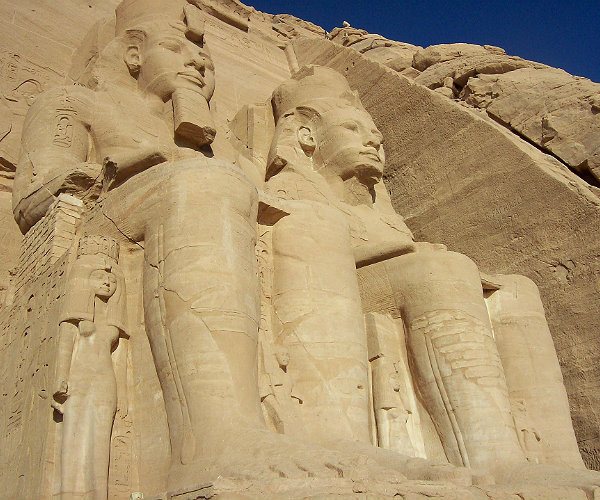 Visiting Abu Simbel: what to expect
Your trip to Abu Simbel may start very early; some trips start heading to the site as early as 3 am. You will be dropped off at “a parking lot”, and then will walk for about five minutes towards the temples (We recommend wearing close-toed shoes, as the road is sandy and gravel-filled). You will visit the first temple of Ramesses II as you walk around the corner of the cliff area. Then, come to a smaller temple, which is dedicated to his wife “Queen Nefertiti”.
Both temples are covered with statues and engravings of a number of gods and symbols. You are allowed to enter them and explore the great hieroglyphs and sanctuaries inside. There is a lot of history to be taken in, so we highly recommend going with a good guide and paying more attention to everything he says about the great Abu Simbel. Make sure to bring a lot of water and sunscreen, as it gets extremely hot at the site and you’ll also be exposed to ample sunshine.
Visiting Abu Simbel: what to expect
Your trip to Abu Simbel may start very early; some trips start heading to the site as early as 3 am. You will be dropped off at “a parking lot”, and then will walk for about five minutes towards the temples (We recommend wearing close-toed shoes, as the road is sandy and gravel-filled). You will visit the first temple of Ramesses II as you walk around the corner of the cliff area. Then, come to a smaller temple, which is dedicated to his wife “Queen Nefertiti”.
Both temples are covered with statues and engravings of a number of gods and symbols. You are allowed to enter them and explore the great hieroglyphs and sanctuaries inside. There is a lot of history to be taken in, so we highly recommend going with a good guide and paying more attention to everything he says about the great Abu Simbel. Make sure to bring a lot of water and sunscreen, as it gets extremely hot at the site and you’ll also be exposed to ample sunshine.
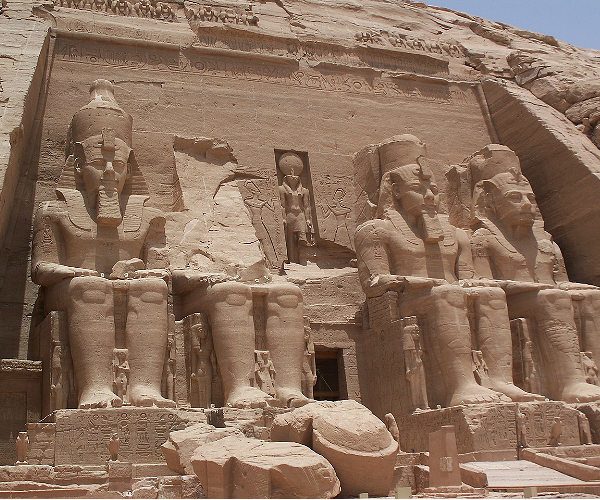 About Aswan
Abu Simbel may be the key sight, but there are plenty of wonders to visit if you’re in Aswan for a few days. Aswan is one of the most relaxed and friendly towns in Egypt, which provides a tranquil interlude if you’ve just arrived from Cairo or even the nearer Luxor. It is a perfect base for exploring the greatness of the Egyptian monuments, temples and other attractions.
The best way to discover Aswan’s beauty is to hop aboard a felucca (small sailboat) to explore the town from the watery highway. The Nile River there is speckled with one-of-a-kind islands holding picturesque mud-brick Nubian villages and hemmed by the West Bank’s colossal sand dunes.
It’s all incredibly photogenic! Especially at sunset when hundreds of lateen-sailed feluccas take to the Nile and the river shimmers in the setting sun.
What you shouldn’t miss while visiting Aswan
Elephantine Island
Elephantine Island is one of Aswan’s major tourist attractions; peppered with palm tree plantations and sloping villages of colorful mud-brick houses. You can find the Aswan Museum and the Ruins of Abu at its southern end, which isAswan’s most ancient settlements.It contains the Old Kingdom Temple of Khnum and the Temple of Satet. The museum building, in a beautiful late 19th-century villa, is partially open, with a collection of artifacts that span Elephantine Island’s history up to the Roman era.
Nubian Museum
One of Egypt’s best and most interesting museums in the history and culture of both ancient and modern Nubia. It documents the riches of the Nubian culture, which was all but washed away with the building of the Aswan High Dam and Lake Nasser. There you can meet a unique collection of artifacts from the ancient Nubia Kingdom of Kush, as well as plenty of wonderful black-and-white photos of UNESCO’s incredible project to save Philae Temple and Abu Simbel. Don’t miss the slumping mud-brick mausoleums of Aswan’s Fatimid cemetery, which is located just behind the Nubian Museum.
About Aswan
Abu Simbel may be the key sight, but there are plenty of wonders to visit if you’re in Aswan for a few days. Aswan is one of the most relaxed and friendly towns in Egypt, which provides a tranquil interlude if you’ve just arrived from Cairo or even the nearer Luxor. It is a perfect base for exploring the greatness of the Egyptian monuments, temples and other attractions.
The best way to discover Aswan’s beauty is to hop aboard a felucca (small sailboat) to explore the town from the watery highway. The Nile River there is speckled with one-of-a-kind islands holding picturesque mud-brick Nubian villages and hemmed by the West Bank’s colossal sand dunes.
It’s all incredibly photogenic! Especially at sunset when hundreds of lateen-sailed feluccas take to the Nile and the river shimmers in the setting sun.
What you shouldn’t miss while visiting Aswan
Elephantine Island
Elephantine Island is one of Aswan’s major tourist attractions; peppered with palm tree plantations and sloping villages of colorful mud-brick houses. You can find the Aswan Museum and the Ruins of Abu at its southern end, which isAswan’s most ancient settlements.It contains the Old Kingdom Temple of Khnum and the Temple of Satet. The museum building, in a beautiful late 19th-century villa, is partially open, with a collection of artifacts that span Elephantine Island’s history up to the Roman era.
Nubian Museum
One of Egypt’s best and most interesting museums in the history and culture of both ancient and modern Nubia. It documents the riches of the Nubian culture, which was all but washed away with the building of the Aswan High Dam and Lake Nasser. There you can meet a unique collection of artifacts from the ancient Nubia Kingdom of Kush, as well as plenty of wonderful black-and-white photos of UNESCO’s incredible project to save Philae Temple and Abu Simbel. Don’t miss the slumping mud-brick mausoleums of Aswan’s Fatimid cemetery, which is located just behind the Nubian Museum.
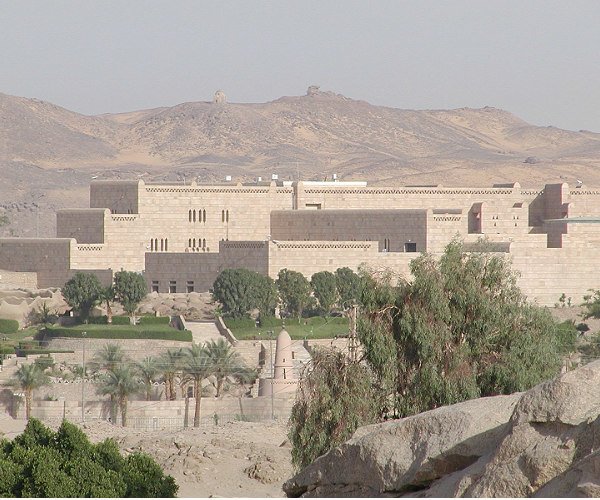 Philae Temple
Also known as “the sacred Temple of Isis”, it is one of Upper Egypt’s most beguiling monuments both for the exquisite artistry of its reliefs and for the gorgeous symmetry of its architecture. Just like Abu Simbel, the temple was saved by the rising waters of Lake Nasser by UNESCO’s rescue project and moved lock-stock-and-barrel from its original home on Philae Island to nearby Agilika Island (a higher one).
Philae Temple
Also known as “the sacred Temple of Isis”, it is one of Upper Egypt’s most beguiling monuments both for the exquisite artistry of its reliefs and for the gorgeous symmetry of its architecture. Just like Abu Simbel, the temple was saved by the rising waters of Lake Nasser by UNESCO’s rescue project and moved lock-stock-and-barrel from its original home on Philae Island to nearby Agilika Island (a higher one).
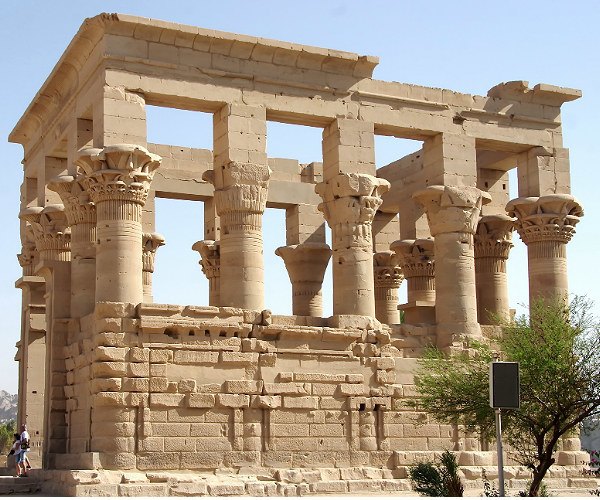 Monastery of St. Simeon
Founded in the 7th century and finally abandoned in the 13th century due to water shortages; it’s one of the largest and best-preserved Coptic monasteries in Egypt. It’s located between the sand dunes on the Nile’s West Bank. An aisled Basilica placed at the monastery courtyard, by the southern side of the monastery, while once covered by two domes, is the large apse, with three rectangular niches under semi-domesat the east end of the wide nave. Yet, in the central niche are the remains of a fresco depicting Christ enthroned between angels.
Things you shouldn’t miss in Aswan at sunset
Felucca tours
In Aswan, it’s all about the Nile River and the amazing Felucca rides around its islands. Early evening is the best time to take to the river if you want to record unforgettable memories.
Monastery of St. Simeon
Founded in the 7th century and finally abandoned in the 13th century due to water shortages; it’s one of the largest and best-preserved Coptic monasteries in Egypt. It’s located between the sand dunes on the Nile’s West Bank. An aisled Basilica placed at the monastery courtyard, by the southern side of the monastery, while once covered by two domes, is the large apse, with three rectangular niches under semi-domesat the east end of the wide nave. Yet, in the central niche are the remains of a fresco depicting Christ enthroned between angels.
Things you shouldn’t miss in Aswan at sunset
Felucca tours
In Aswan, it’s all about the Nile River and the amazing Felucca rides around its islands. Early evening is the best time to take to the river if you want to record unforgettable memories.
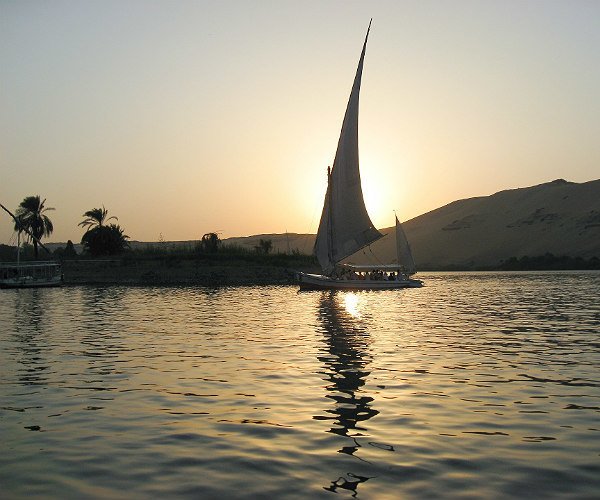 Camel rides
If you’re looking for something more active, then camel rides on the west bank, Aswan is all that you’re looking for! The best time to go for it is at the end of the day, when the worst of the heat has finished! Sunset camel rides from the Tombs of the Nobles to the Monastery of Saint Simeon (or vice versa) are hugely popular on the west bank.
Camel rides
If you’re looking for something more active, then camel rides on the west bank, Aswan is all that you’re looking for! The best time to go for it is at the end of the day, when the worst of the heat has finished! Sunset camel rides from the Tombs of the Nobles to the Monastery of Saint Simeon (or vice versa) are hugely popular on the west bank.
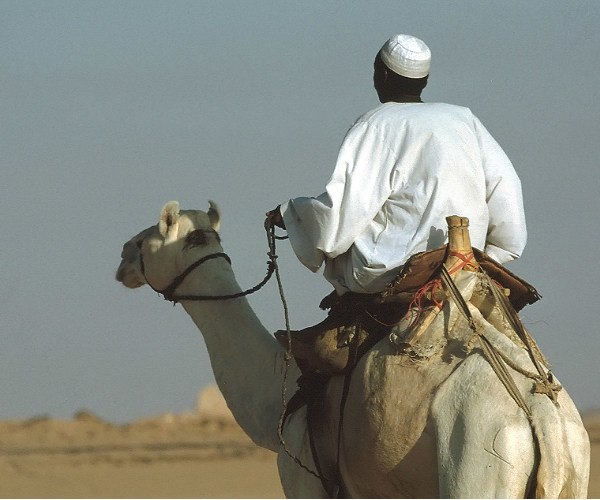 Aswan is Egypt’s most laid-back town., yet Egypt has other major cities such as Luxor, which is the most important city to visit if your visit is all about Ancient Egypt’s temples and tombs. Also, you may love to come across Alexandria, which is imbued with the creaky ambiance of Egypt’s Belle Époque period. Furthermore, there is Cairo – the bursting-to-the-seams capital, which is packed with historic buildings and with the Giza Pyramids on its doorstep.
Sherif Khalil is Owner of Dunes & Beyond. Dunes & Beyond offers luxury tours, Nile cruises and desert safaris in Egypt.
If you would like to be a guest blogger on A Luxury Travel Blog in order to raise your profile, please contact us.
Aswan is Egypt’s most laid-back town., yet Egypt has other major cities such as Luxor, which is the most important city to visit if your visit is all about Ancient Egypt’s temples and tombs. Also, you may love to come across Alexandria, which is imbued with the creaky ambiance of Egypt’s Belle Époque period. Furthermore, there is Cairo – the bursting-to-the-seams capital, which is packed with historic buildings and with the Giza Pyramids on its doorstep.
Sherif Khalil is Owner of Dunes & Beyond. Dunes & Beyond offers luxury tours, Nile cruises and desert safaris in Egypt.
If you would like to be a guest blogger on A Luxury Travel Blog in order to raise your profile, please contact us.Did you enjoy this article?
Receive similar content direct to your inbox.


I’ve got to agree that a felucca sail on the Nile is one of the great Egyptian experiences, especially if you sail around sunset. We did it as part of our honeymoon to Egypt over 30 years ago and it was certainly one of the highlights of the two weeks.
I hadn’t realised Ramses II was in Abu Simbel. Actually, I think Abu Simbel gets very little coverage compared to the most popular tourist areas of Egypt. My brother’s been to Egypt but I’m not sure he made it here. Hopefully a little more awareness of the village can boost tourism which will help the situation for locals and inhabitants of the area. The temples would be incredible to see, especially if you can go when the solar alignment is happening. It’s strange to think it’s always the same two days each year. Is there ever any variation on that, or is it a definite every year? I had expected more walking so it’s great you can be dropped off only 5 minutes away from the temples. I imagine some would find the heat a bit too much to be walking around too long in. A boat ride on the river would be a must I think, too, a lovely way to round off the day by taking in the views like that on an evening.
If anybody is putting together a Top 10 wonders of the world, for my money, Abu Simbel has got to be up there, pushing to get onto the honours list. Well worth making that trip along the Nile.
Egypt is one of my favourite places to visit. I like to try to get back there every 5 or 6 years. Like most places you get back what you put in. Ancient Egypt is very distant from today’s high-tech world where we try to explain everything with science. What I’m saying is that you need to spend some time doing some background reading to get yourself tuned into the world view of the Ancient Egyptians. Buy a guide book or download some travel guides for a little bit of reading on the flight.